What's the matter with Mechanized Infantry?
WHAT MECH-INFANTRY SHOULD BE:
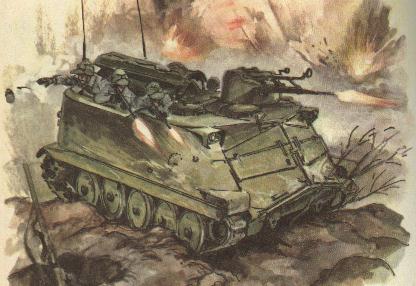
Good, light infantry that fights from their tracked armored fighting vehicle (illustration is missing gunshields) that can dismount before or after the objective to finish the enemy off. Small 1-man autocannon turret weaponry not so over-powering that the infantry cannot fight from their own vehicle....
WHAT MECH-INFANTRY SHOULD NOT BE:
TOTALLY BUTTONED UP IN THE BACK AND CLUELESS: "Bradley Disease"
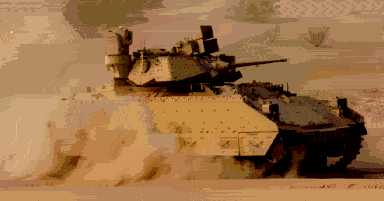
ASLEEP IN THE BACK, NOT ALERT AND BEHIND GUNSHIELDS: "LAV/Stryker ease"

Look at this atrocious picture of marines rolling into Kosovo in a LAV-Mortar carrier! This is "MECH-infantry disease" in action! In KOSOVO! When its supposed to "count" and be for "real"..as you can see you fight as you train...
1. No face paint camouflage, excellent aimpoint for gunmen/snipers
2. Weapons sling not taped or camouflaged
3. No gloves or camo on hands, more aimpoints
4. No camouflage band on helmet or camouflage
5. Buddy sitting on ass in vehicle not covering a sector
6. Vehicle Commander with LBE draped over top hatch so it cannot close in event of shell bursts, Molotov Cocktails or grenades being tossed in
7. Unloaded Medium Machine Gun, no gloves
8. People too close, can easily ambush vehicle
9. Noone with mine rollers checking ahead for mines, demolitions bombs
10. Bonehead has first aid kit clipped precariously to side of butt pack
11. No camouflage on CVC helmet, probably without ballistic shell. Sun, Wind Dust Goggles (SWDGs) not covered to prevent shine.
12. Vehicle itself not sandbagged or camouflaged
An Army NCO writes:
"Mike, thank you for your timely reply.
I agree with you on several points.
...I agree we do need to add mobility to the infantry but at the same time advise caution. I had the unfortune of being in light units that went mech. Suddenly the whole focus became Bradley's and all training was relagated to the motor pool. NCO's and Officers suddenly thought they were tankers. All PT stopped... All Dismounted training stopped. The Sniper, Pathfinder and Ranger schools came last down a long list of table 8 scores, maintenance and UCOFT qualifications. The moral, discipline and standards went to hell very rapidly. A lot of the NCO's, Officers and EM's that came into the unit had never done ANY ground tactical training or PT since Boot Camp. The problem is that over time and every PCS these folks always found themselves back in the track. Any mech unit knew that to succeed in peace-time they had to put the most experienced in the Bradley. These folks had no idea even how to integrate their own dismounts due to the fact that they had never been one. Unless a sound, competent and very enforced policy is put into place this would happen to the Airborne and Light forces over time."
His words have been proven true. Discussing this issue further in my BFV unit, I get the following idea that seems to dominate everything we do:
"Let's fully man the BFV crews THEN we will do dismounted training".
The funny thing is, after 2 years the BFVs are still not fully manned and we never seem to get around to dismounted maneuver training.
The idea that we should have a mounted-only focus kills dismounted training from ever happening by driving away those that are capable of being dismounted infantry and negatively affecting the minds of the leaders who remain into a mounted-only mentality. When you as a policy, a mentality or a mindset say "vehicle first" you automatically place dismounted maneuver "second" and this kills the life-blood, warrior spirit of the infantry which is men using their bodies as the vehicle to close with and kill the enemy. Our young men sign up to be infantrymen not tankers; when they find out that if they stick around they will become tankers (BFV crewmen) they leave. If our pipeline was coming from Fort Knox, perhaps it would be ok...but let's examine the BFV manning first idea....
1. What we have now
Let's say you man all 3 Platoons with a 3-man crew and all the BFVs are empty except for about 15 men who haven't gone to 11M school or are trained in the turret. So what do you do? For years at a time those in the BFV lose whatever dismounted skills they have, perhaps pick-up a mounted mentality and the orphans with no training program for them get stuck doing shit details to support BFV Gunnery evolutions. Soon these folks are gone and a few in the BFV's crew positions leave unfulfilled never getting to do infantry tasks and we have a repetitive cycle where we never get enough people to have a "winning team".
2. What if we had everyone we needed?
Let's play devil's advocate, let's say we wiggled our noses and by magic we became fully BFV crew manned and dismount manned. Most Army BNs went from old M113A2 Gavins to BFVs with over 100% strength----so it actually did happen. When the BN started BFV NET it was fully manned. So the fully manned BFV unit goes to training, its a BFV Gunnery evolution. The primary crews get qualified, what happens next? The dismounts stand around and watch because we have decided to make our lives easy and conduct only one type of training per day or drill weekend for the NG or for the entire year. Never mind that while these people stood around they could be doing EIB tasks or doing land nav lanes or battle drills. Those in charge don't want this training to happen (yet) because we don't have enough time for them to supervise it which cannot happen if they are busy qualifying on some myriad of BFV tasks. If some time remains, certainly not enough to set up a different type of training (dismounted maneuver tasks) the dismounts are placed into BFV crew positions and shoot for "familiarization" because in case of combat, the BFV crew member gets taken out and they might need to fill in. The drill weekend's time is up.
Where is the dismounted maneuver training?
When does it ever happen?
When will the dismounted maneuver element EVER get up to speed and running?
It will not.
BFV gunnery and vehicle tasks will eat up whatever time/resources are left.
The solution: do two things at the same time
The only way it will work is we have to do TWO TYPES OF TRAINING at the same time. It will take more work, more effort. You have to SIMULTANEOUSLY train dismounted maneuver elements and mounted elements and bring the two together to do it right. I know many who are not up to this task, they'd rather show up for drill, do PMCS and drive/gun a BFV, hit the barracks, get drunk in town, return next day, PMCS..wash rack go home. I'm not saying I'm against being anti-fun. But if we let baser instincts dominate, the opportunities for "fun" will be limited to just goofing off. Foot infantry stuff can be FUN, but you have to do it enough so you are not getting blisters on your feet and be in physical condition so those phermones kick in so it becomes fun. Throw in pyro and you have a kick-ass unit that is at 100% stength plus. BECAUSE WE ARE CHANGING PEOPLE FOR THE BETTER. PEOPLE IN AN INFANTRY UNIT ARE CHANGED IN A GOOD WAY, THEY WALK AWAY FROM TRAINING FEELING EXCITED AND MOTIVATED ABOUT HAT THEY DID. WE ARE CHALLENGING THEM PHYSICALLY IF THEY ARE DISMOUNTING AND DOING FULL MANEUVER TASKS. If they sit in a BFV all day eating MREs and smoking they are NOT getting better and stronger. This training outlook is proven effective as can be seen from our simpler-vehicle M113A2 Gavin past. But if we keep "pounding our heads against the metal hulls of our BFVs" demanding that we fill them up first, we will kill the human spirit needed to be dismounted maneuver infantry.
In my life I have been on three, "winning teams". First was in High School Wrestling, the second was in the Mc Reserves and the NG at NTC in M113s as OPFOR. In all 3 situations they as organizations decided BY CHOICE that they "had enough people" and went from there. Surprisingly they actually were short-handed but the people came. They became "fully manned" or they won with what they had and they won championships.
On the other hand, I have been in many outfits where they constantly said they didn't have enough people to act like or become champions. And they never got them, either.
The moral of this is we have to stop using the "not enough people" thing as an excuse to not live up to Army standards and be the champions we want to be. If we would take what we have and start doing it right by mandating that we have BOTH a mounted and a dismounted training PLAN with equal Battalion Command emphasis we will keep our people and mold them into the end-state we want---a true infantry-centric Mechanized Infantry unit. We have to decide to value dismounted infantry maneuver just as much as BFV Gunnery even if higher headquarters doesn't.
Otherwise we will continue to have empty BFVs, empty units from those dismount slots not filled and eventually the BN will be disbanded for failing to fill its ranks.
We have given the "fill the BFV crews first, then do dismount training" idea at least 3 if not 4 years. It has failed, does an Infantry Battalion in a budget-cutting era have the luxury of another 3-4 years to continue to fail with this policy, dying a slow death by mediocrity? Clearly, DRASTIC changes are needed.
When I mean DRASTIC I mean the kind where you order Soldiers to do the things we need to do to be champions and if they refuse to carry them out in spirit and letter, confront them with this. Some feelings are going to be hurt, because despite our aversion in the 2000s of saying this, people can be WRONG. This is not a matter where we can gently "steer" the Battalion into the right direction. There are people, perhaps even many who simply do not wantt o do it. You can't just do token or half-ass dismounted infantry maneuver training, because either you open the vault and lift/sign out for the rifles, machine guns and NVGs and place camouflage on your body and equipment and start walking through the woods along mapped training areas previously secured or it doesn't happen. It can't be pencil-whipped. The dismounted training either is done or its not, and to do both simultaneously will take more work from not enough people. Its too easy to have Company Commanders use the time/resources and its "too tough" excuse box to veto the transformation and have the dismount training "not happen". The result is Soldiers "not showing up for drill" because they are tired of standing around the drill center wiping down clean weapons or cutting the grass all day for entire weekends when they could be doing dismounted battle drills, EIB tasks, ruck marches, shooting in the indoor range with NVGs etc. For this kind of training to occur, there has to be a BATTALION POLICY AND MANDATED DISMOUNT MANEUVER TRAINING PLAN IN EFFECT with a "point man" IN THE COMPANY who attends training meetings who has by Battalion authority the power to execute FULL dismounted maneuver training or it will simply not take place. He could be termed an "Infantry Master Tactician" (IMT) who would be a dismounted version of a BFV "Master Gunner".
Let's make no mistake about this. In the National Guard we have an average Soldier age in the 30s. This is not hard to see resulting in a gravitation towards the "mounted mentality". Older guys simply do not want to dismount. That's ok as long as this "mounted mafia" stays in their BFVs and doesn't make the young guys who want to dismount leave the unit by the general lack of vigor that results from having nothing to do tactically when away from the BFVs if the mounted mindset trumps all. We have many new, young Soldiers in the Army NG, it would be a shame if we lose them to the mounted malaise. The excuses for not doing dismounted training range from "the IG inspection" to "CTT" or "we have to catch up on paperwork". The mounted mentality Soldier NEVER seems to find the time to train for dismounted tasks especially since he lives under the "Let's fully man BFV crews THEN we will do dismounted training" cloud hanging over his head.
For example, we just got brand-new M16A2 5.56mm rifles which we cleaned even though they were not dirty, only being fired from the factory. We wasted an entire drill weekend on this baby-sitting task because we simply didn't want to expend the effort to do dismounted maneuver training. And the men's attitude? "These are hand-me-downs from another Company". This is outrageous! Here they are with a Colt-made, never been field fired, brand-new, best Assault Rifle in the world and noone is talking it up. Noone is giving them a class on their improved features over the M16A1, we have castigated them as hand-me-downs. And no, an E5 can't stop and give a hip-pocket class on the M16A2 while they are being cleaned because someone who is an E6 and above has to walk by and be a kill-joy and say, "SGT we have to get these weapons cleaned for the IG inspection, we will have classes on the M16A2 later". "Later" never comes. "Go along to get along" means mounted mentality mediocrity. It means don't change the laid-back status quo, stand by and watch our BN die a slow death. If "later" does come its the day of annual rifle qual and everyone is confused about the 3/8 rear elevation drum setting problem and worried about not qualified......then they will say; "Don't tell us about that, just tell us about the proper BZO procedures"...what's lost is the full appreciation and understanding of this fine weapon and the skill to fully use it....Why? Its all about getting by with the MINIMUMs and not achieving MAXIMUMs. Maximum takes maximum effort. Champions do everything they can TODAY to get squared away.
To be frank, there may be leadership in the NG/Active Army BFV community that doesn't want to train or fight dismounted, period. Because when you do make this training happen, you have to be forceful to overcome inertia and they resent it and try to use minutae about "procedures not being followed" or "you are pissing people off" as reasons to veto the training by personal attack. Of course dismount training pisses people off!----they simply do not want to get out of the BFV. This is the bottom line. Some colored by their experiences in the open in Desert Storm are seduced by the 25mm chain gun as the solution to every battlefield problem. They see life in a BFV unit as an easy life where the BFV does the work. You come along and remind them in closed terrain places like Korea, JRTC or Iraq their BFV chain gun will NOT dominate, and dismounted infantry action will, and they are upset. Of course they are! You can't eat MREs and smoke all day in the BFV if you armed to the teeth ready to dismount or are already operating away from the BFV.
Everyone says they want to be champions. Few are willing to do what it takes to become champions. It requires STRUGGLE, this means stepping on toes at times, it means sweat, it means cuts/scrapes and bruises as you push the "envelope". Doing minimums and being in a comfort zone will not get anyone to a championship level. War is a life/death struggle where the winners survive, the losers die or are maimed. For our BFV Battalions to continue to exist it they have to be a champion as laid-back mediocrity has already killed many NG units. In challenging times, short handed it needs to decide to elevate dismounted maneuver training as a way of life by BATTALION POLICY AND SEPARATE TRAINING PLAN THAT CANNOT BE VETOED AT COMPANY LEVEL. Perhaps consolidate all BN dismounted training if the BN drill on the same weekends? Somehow through OPD/NCOPD we need to cure the mounted warfare mentality, perhaps mandating officers and NCOs read books like B.H. Lidell-Hart's Strategy and John English's On Infantry. Ranger School and Light Leaders Courses and perpetual BN EIB training/testing would be even better.
A U.S. Army tactical analyst writes:
"Shift in focus...
Have you been following Force XXI and the Operations and Organizational Concept for the Conservative Heavy Division (CHD) coming out of Leavenworth? In my opinion, it is a blueprint for disaster.
Having read the draft 9 page concept, I see absolutely NOTHING new in it when compared to the June 1990 edition of FM 71-100, Division Operations. Sure, they have changed all the words and made up a bunch of new terms, but there is nothing new or innovative anywhere in it. The information warfare piece can much more readily be overlayed onto the existing division structure without any significant redesign needed.
The 'innovation' of dispersed operations, having our troops scattered all over the place and converging on the enemy on order, is nothing new, either. It presumes that we have information dominance and know exactly where the enemy is (and by inference, is not). Kind of like the Germans assuming the rear areas in Ukraine and Poland were secure in 1942-44. We tried it in Vietnam, too. Battle of Ia Drang, I believe, where our troops got ambushed while returning to the LZs. Now, if you DO believe that our technical capability is adequate to locate the enemy, then we can save lots of manpower by eliminating the Armored Cavalry Regiment, the Divisional Cavalry Squadron, and the battalion Scout Platoons. You can also reduce the number of tank battalions, since you can kill the enemy with smart artillery and do not need to close any more. If, onthe other hand, you doubt our technical capability to positively locate the enemy, then the whole effort is moot.
'Velocity management' of repair parts and consolidation of maintenance at higher levels is bogus, also. It is real simplistic to talk about repair parts being delivered almost instantly to the vehicle crew, but it overlooks the obvious. Someone has to troubleshoot the malfunction and determine the appropriate component to be replaced. Someone has to physically replace the defective component. Now, it is really nice to talk about self-diagnostic sytems that self-troubleshoot and self-isolate faults, but they are not out there, yet. Nor will we retrofit such capability into existing systems (tanks, APCs, trucks, HMMWVs, generators, tank & pump units, etc., etc.). So what's the point of talking about something that will not exist?
Well, if the leadership really wants to pursue CHD and Force XXI, we are in big trouble. It's a shame that the process has degenerated to this. Nobody seems to care, let alone understand, existing doctrine before going off on these gee whiz excursions."
A U.S. Army Infantry Captain writes:
"I will always think of Mech Infantry as having grunts-in-the-trunk. They spend a lot of time driving around pretending they are tankers and they never want to let the grunts out of the back. I was a light guy I never wanted to be treated as cargo."
2-MAN TURRET SMOTHERS INFANTRY IN THE BACK: TYPE "A" PERSONALITIES LEAVE UNIT BECAUSE THEY DON'T WANT TO BE SECURITY GUARDS FOR TANKS
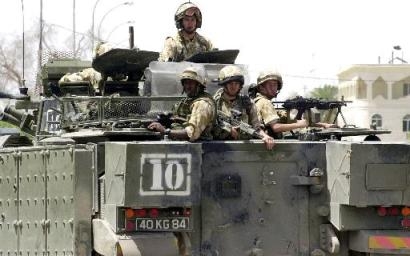
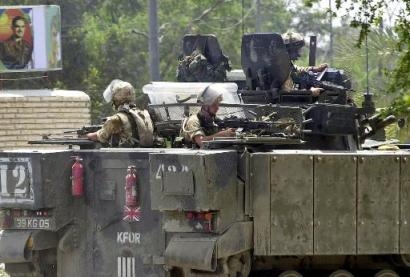
A British Army vehicle patrols the center of Basra, southern Iraq (news - web sites), after gunmen loyal to radical Shiite cleric Muqtada al-Sadr attacked British patrols and government buildings, Saturday, May 8, 2004, a day after an al-Sadr aide offered worshippers money for capturing or killing coalition Soldiers. (AP Photo/Nabil Al-Jurani)
Before the advent of the medium-heavy Bradley, America's Army had a VERY GOOD light mechanized infantry in M113 Gavin light tracked AFVs. The mistake was not maximizing M113 Gavins and supplying them to the Army's light infantry units through a transportation battalion or the Delta Weapons companies in every infantry battalion. The Gavin doesn't have a large 2-man turret that forces the dismounts in back to stay buttoned up due to converns that concussion from the 25mm gun or its barrel swinging into them if they stand up through the open top rear troop hatch. When units converted from M113 Gavins to Bradleys, many of the aggressive, Type-A personalities left because they soon found it unworkable to see what's going on through just narrow vision periscopes and didn't want to be second-class citizens to the "turret mafia" who want to fight the BFV as a tank. Tragically, the USMC is making the exact same mistake as the Bradley with their oversized, overpowering 30mm turret they are putting on the AAAV.
There is a turret combat over-ride switch in the BFV turret to enable the 25mm gun to fire if top hatches are open and traverse. We have seen 1st Cavalry Division BFVs with troops standing up through the top rear troop hatch in Iraq to get better surveillance capabilities. But t shouldn't have taken COMBAT to get this TTP in use. The British Army has discovered they need the dismounts fighting out from the top rear troop hatches of their Warrior MICVs in Iraq, too (see photos above) to prevail on the non-linear battlefield (NLB) where the enemy can attack in any direction at any time. However, these are ad hoc, expedient measures that should have been done in peacetime training so laser tag instead of real deaths would have optimized the practice with fold-down gunshields. The BFV top rear troop hatch can be set in an upright position to act as a rear gunshield and to stop the 25mm gun barrel from hitting the troops if the turret crew should traverse too far. The turret crew will have to be careful where they traverse and only fire the 7.62mm co-ax until they can alert the dismounts to button up through one of the latter's headset via the intercom. Its not ideal but better than being buttoned up and having vigilance limited to just where the eyes of the turret crew are facing.
The ultimate answer to the BFV's infantry smothering is to REPLACE THE 2-MAN TURRET WITH A 1-MAN TURRET so the BFV can be commanded by the infantry in the back which we discuss below. To regain a true light mech infantry that can fully maneuver by aircraft, swim, go cross-country at will, we need to upgrade our M113 Gavin light tracks with extra armor, ACAV-type gunshields and supply them to our light troops. Moreover, EVERY BRADLEY MECHANIZED INFANTRY BATTALION HAS OVER 23 x M113 GAVIN LIGHT TRACKS, ENOUGH TO LEAVE THEIR BFVS HOME AND GO "LIGHT MECH" IF THE SITUATION DICTATES. The infantry in a BFV mechanized infantry unit should NOT see themselves wed to their BFVs but be willing and train to be very able at fighting on foot and in their lighter M113 Gavins if air-transportability, amphibious capability and all-terrain agility are needed for the mission due to enemy, terrain, troops, time etc. All this takes is some flexibility of mind in the leaders of these units.
All anyone has to do is visit any of the U.S. Army's 6 active duty heavy divisions and they will see that 50% of the entire unit rides in M113 Gavins. You'd have to go to Iraq to see the 1st Cavalry and 1st Infantry Division's Gavins in action. 1,300 Gavins are IN COMBAT TODAY IN IRAQ.
IF IT WORKS AND ITS NOT OLD, THEN DON'T CALL IT "OLD"
Let's ask our readers a question.
Where are the M48 medium tanks now?
Scrapped or in a museum.
Where are the M41 Walker Bulldogs, M551 Sheridans, M151 jeeps?
Same place, scrapped. Museums except for a few locations/users. Gone. Bye-Bye. History.
Where are M113 Gavins?
M113 Gavins are in COMBAT right NOW in the THOUSANDS all over the world, in the middle east, the far east. The desert. Swamps, jungles, urban, mountains. Dropped by parachutes, lifted by helicopters. Swimming across lakes, rivers and with waterjet kits even oceans. M113 Gavins ain't just "history" they are current events. They are our future due to the enduring nature of modern land combat which M113 Gavins are its master because the need for air-transportable, all-terrain, tracked armored mobility that is simple to operate and maintain against enemy small arms fire never goes away.
No armored combat vehicle has ever been as successful as the M113 Gavin in 5 decades of war; other than the B-52 and C-130 is there anything like it? Vietnam, Sinai, Lebanon, Thailand, Fulda Gap, Korea, Entebbe, Panama, Saudi Arabia, East Timor, Iraq....the list goes on and on. In fact, the M113 Gavin as a ground vehicle made of thick metal that doesn't age will be operable long after structural fatigue grounds B-52s and C-130 aircraft from safely flying. M113 Gavins can and will last forever as long as human beings with even modest industrial means exist.
What we need to do in the time and cash-strapped U.S. Army is BUILD ON THIS WINNER, the M113 Gavin which we have 13,000---stretch the hull by 1 roadwheel, change the engines to hybrid-electric drive, employ band tracks, add infared thellie camouflage, RPG and roadside bomb resistant spaced armor, a 1-man 30mm autocannon turret, waterjets and bow on some operating from RO-RO sealift ships for self-delivery across the beach, others with ACAV/IDF style gunshields all around as a non-linear urban combat vehicles. Parachute them with the Airborne and Air Assault them with the Screaming Eagles. America's Army needs the FULL capabilities of "M113A4" Gavins exploited NOW with a less than $1 million per vehicle make-over not fantasy future combat systems (FCS) that in 2012 we will suddenly discover come at an unaffordable $10 million each so the whole idea is scrapped or bought in irrelevant handfuls as the light units of our army continue to fight and die on foot and in vulnerable HMMWV wheeled trucks.
Details:
www.combatreform.org/m113combat.htm
THE MINDSET OF A TANKER, MISSION OF A GRUNT? = DISASTER
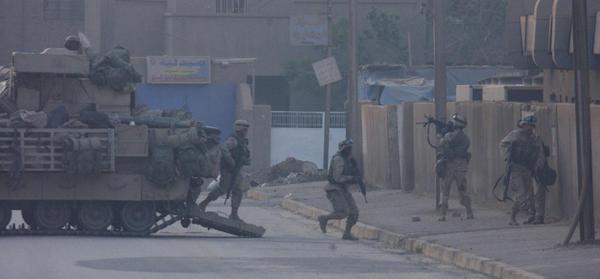
Bradley in Iraq: Where are all the dismounts?
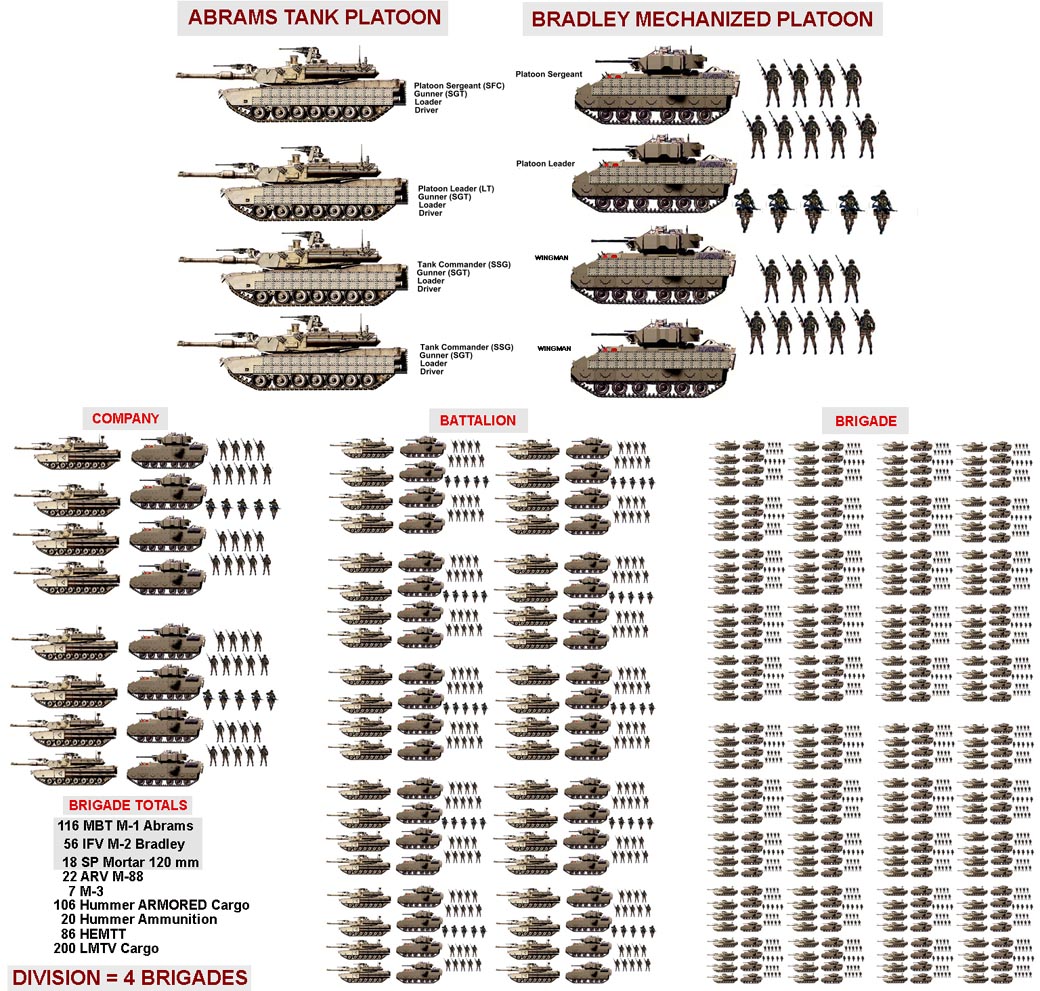
New Modularity Madness: a propaganda poster again forgets to show the 100+ M113 Gavin light tracks ("Tank & Brad" BS mentality) but its AOK to have a couple hundred vulnerable Humvee trucks (not)
The men above have described in a "nutshell", what I call "Mech infantry disease". I could never understand why if you take a light infantry squad and ADD an Armored Fighting Vehicle (AFV) to them, why we end up with LESS fighting power from them? You should have MORE.
As being Mech-infantry at one time, I know why. First, what happens is the guys with a vehicle to carry their stuff, stop living "light". They start taking coolers and their rucks are not ready to go. The AFV becomes their "RV" of sorts. Next, you have the nature of the armored fight where deep down inside, the tankers do not want to stop and have the Mech-infantry dismount, they want them to stay mounted and fight there. Now that the Bradley A2 model's firing ports are covered up by extra armor panels, the infantry "squad" in back sits inside doing nothing because noone is willing to open the top hatch for them to stand up and face out with their weapons like you can in a M113A3 Gavin out of fear the M2 Bradley turret will spin around and kill them. The Bradley is actually a Medium tank...with a few infantry in back. It weighs the same as a M4 Sherman tank from WWII: 33 tons. Thus, they are blind "cargo" as the Captain said. Then you throw in the disdain the light fighters have towards the Mech guys, and you have a less than ideal situation...but one that can be corrected with LEADERSHIP. These guys are great Soldiers, they just need better leadership. What we end up with is ARMORED INFANTRY to support the advance of tanks ("Security Guards for tanks"), instead of MECHANIZED IINFANTRY which defeats enemy forces in its own right by seizing terrain and/or destroying enemy forces by INFANTRY action.
LEADERSHIP DRIVEN BY MODERN BATTLEFIELD REALITIES
This all needs to change.
The Need to dismount
A former Army officer has wrote me on dismount training and he brings out a point about muscle memory and how if our bodies get used to "cacooning" in the vehicle it will be THIS ACTION that gets done during a high-stress situation.
The BFV exists to deliver its infantry ON FOOT to the fight. In closed terrain, infantry ON FOOT leads BFVs, and tanks (JRTC, jungles, former Yugoslavia etc). Fighting mounted using firing port weapons IS an option, but only against light resistance that we are moving through and bypassing.
"I wrote that after looking at your map reading page. I could tell by what you wrote and how you arranged it that the problems you are having and the ones I dealt with were very similar.
I've coached football for a lot of years and have a pretty good reputation for teaching offensive lineman ( usually the least physically gifted kids) how to compete successfully. I go to clinics (football teaching skills) whenever I can and the methods I use were the ones my father used with my brother. At the time there were no names for a lot of this stuff. Now terms like muscle memory are popular. I always catch things on the discovery channel about special ops units using Immediate action drills to improve there skills. These are simply muscle memory drills. This was discovered (in the scientific sense) by the
Soviets. That's why they train there Soldiers and athletes the way they do.
Everything is a drill. We should be doing the same. I remember so clearly how tank crews were so efficient in there gunnery skills but tactically unable to do anything but frontal assaults. No practice was the problem and I couldn't get any of my officers to understand that it takes the same kinds of
repetition as gunnery to be good. Its a sad thing to admit but I always thought I could whip the U. S. Army pretty easily. If you remember the link I sent you about the Soviets in Chechnya it talked about the Russian infantry not getting out of there AFV's and being barbecued alive inside.
I used to watch our own Mechanized INF. and see them basically as passengers who would suffer the same fate. They have to train to get out at every opportunity. The problem was the the TC's. They wouldn't allow there troops to get out of the vehicles because they didn't want to leave anyone behind and it took some time to get them all loaded up after they get out. The problem is they're creating a muscle memory disaster. I recently read something in my readings about an enlisted marine who wanted to thank an officer who had saved him and his unit in WW2 by forcing them to get off the Beach. What caught my attention was him stating that they had been "TOLD, over and over to get off the beach, because that's where the most danger was". Well you can tell someone all you want but when the time comes and the stress is ripping you apart It's the action you practiced that you will perform. Even if it's inaction.
Something to remember about muscle memory. I hammer this into my kids all the time. It takes 300 repetitions for there to be short term muscle memory present and as many as 3000 for it to be permanent. If you do something 500 hundred times and you will achieve optimum efficiency. It takes as few as three times of doing something wrong to confuse your neural pathways and slow
your speed. So many of the people I taught to read maps learned to read maps wrong to start with. That's why I used ( an Use) repetition and drill to undo what they had learned. The important thing is to place your drills where it will have the most effect. For instance the marines should have practiced
disembarking from there landing craft and getting off the beach over and over. I would never have allowed them ( not even once) to get out of that landing craft and not get up the beach.
That's the part they should've practiced. I'll bet they practiced getting in to the landing craft more than anything. That's the part most officers saw and probably considered most important. I would have made it difficult and dangerous to get off the beach and we would do it a thousand times a week. I
would permanately anchor a landing craft on the beach and drop the ramp and have them charge up the beach day after day after day. I would change the obstacles in front of the landing craft all the time and make it as stressful as possible. I would also make sure they always got at least 500 meters inland. I would do it at night, with live fire, carrying hundred pound rucks
and carrying casualties. It would be absolutely brutal. There would be no need for aerobic conditioning when I was done.
Simple things like unloading wounded from Bradley's have to be practiced by everyone. I watched the Germans doing this and suggested we practice doing it also. The results were disastrous. We almost killed the man posing as the casualty. My Plt. leader looked for manuals on how to accomplish it and wasn't able to get his hand on one. Finally a medic who had been in the 11th Cav showed us how to do it. We spent
some time doing it and got pretty good after a short time. That's how I would start my lesson. Tell them we have to practice this for the ones that don't want to get out of there vehicles. Because under fire it's more than likely the only way we'll get you out."
The need for light Armored Fighting Vehicles in light divisions so they are no longer a "them" but an "us"
First the superb M113A3 Gavin Armored Fighting Vehicle.
www.reocities.com/equipmentshop/m113combat.htm
...with its RPG and auto-cannon resistant applique' armor attached needs to be provided in about a dozen vehicles each to every U.S. Army Light Infantry Division instead of a dozen FMTV trucks that weigh exactly the same: 22,000 pounds. This vehicle allows the Soldiers to stand up and fire weapons as the vehicle moves, see the battlefield and dismount with an idea where they are going. This would give light divisions the "punch" they need ORGANIC to them so they can train with them and be ready, and not have them denied as the Rangers were not supplied with AFVs in Somalia. The air-droppable, heli-transportable M113A3 Gavin in the force structure of the Airborne/Air Assault and Light infantry Divisions is critical as a firing/transport platform to maximize the revolutionary capabilities of the zero firing signature, self-guiding Javelin Anti-Tank Guided Missile (ATGM).
Next, in ALL MECH-Infantry units videos of the current generation of signature-less Russian anti-tank guided missiles needs to be viewed so they realize the "Sagger drill" upon muzzle flash will in the future not work. There will be no muzzle flash. The only thing you will see will be the missile creaming your vehicle. Thus, MECH infantry will need to clear out possible ATGM firing positions ahead of the M1 MBT tankers by advance detection using forward looking infared (FLIR) devices like the Dragon ATGM night tracker or Javelin Command Launch Unit (CLU) sight, the former is too heavy to hump and gets left in the arms room doing nothing, and good patrolling skills. MECH infantry units need to be fully manned with dismounts, and the Javelins placed in a 6 x M113A3 platoon force organic to the infantry battalion as proposed by LTC Martin Stanton in the Jan-Feb 1998 Infantry magazine.
To get the latter, we need a better, more tactically oriented Infantry AIT taught by a Combat/Survival cadre not drill sergeants from a One-Station Unit Training parade ground drill & ceremony mindset.
www.reocities.com/Pentagon/Quarters/2116/fixait.htm
This would deliver, a tactically ready, Soldier able to step in from day one at an Infantry unit and contribute to the fight, not require in-house training from scratch as takes place now.
The Soldiers need to learn how to "self-start" and educate themselves to master individual skills by preparing for and earning their Expert Infantryman's Badge (EIB) at the www web site:
www.reocities.com/Pentagon/9063
Their Squad Leaders need to attend a Combat Leaders Course put on by their division:
www.reocities.com/Pentagon/Quarters/2116/squadleadertraining.htm
Next, the realization that we no longer "own the night". We must practice the stand-off attack, where the noisy vehicles stop short of the target outside of enemy detection range as the assault force speed marches at 4-7 mph on foot (like IDF Paratroops or our own Darby's Rangers in WWII) along routes secured first by security elements with "eyes on" the target for days beforehand....to close in on the enemy to assault him. Once the shooting starts, the AFVs close in and provide direct fire support.
There are a host of enhancements that can be done to improve the Bradley IFV at the unit level; strap painted and sandbag bottomed ladders to their sides will facilitate urban assault tactics at unpredictable spots on buildings. The weapons squad needs Carl Gustav 84mm Recoilless Rifles to bolster urban combat firepower. Called M3 "RAAWS", Carl Gustavs are used solely by Rangers. Details for these enhancements can be found:
www.reocities.com/Pentagon/Quarters/2116/urbanarmor.htm
www.reocities.com/Pentagon/Quarters/2116/carlgustav.htm
One thing United Defense (makers of the BFV and M113A3 Gavin) and the Army needs to do is to REPLACE THE BFV's turret! This is the source of the "disease" that places vehicular lust-to-be-a-tank, and training focus on the BFV's weaponry instead of the infantry inside.
One turret does it all? The unobtrusive gun/missile turret
M2A2 BFVs can only carry 7 dismounts so imagine trying to spread 3 x 9 man squads over 4 x BFVs....
A M2A2 BFV weighs 33 tons.
If you removed the turret the best we figure is you save 3 tons of weight.
3 x 30-ton BFVs = 90 tons or 180,000 pounds, exceeds the 170,000 pound limit for the C-17.
You could remove the side skirts and lose maybe another 2 tons per vehicle, so you'd be at 174,000 probably do-able.
As you know its easier to add armor to 5 x M113A3 Gavins to exceed BFV protection levels than to strip down BFVs and get them light enough to fly 3 at-a-time in a C-17.
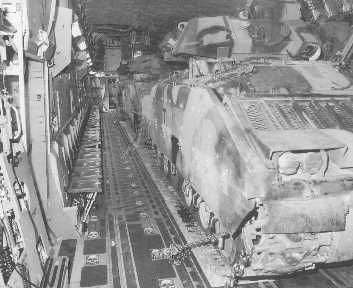
The old M2A0 BFVs only weighed 25 tons and you could at 150,000 pounds fly them 3-at-a-time in a C-17 (just as many as the bloated Lav3Stryker armored car). We still have old M2A0 BFVs running around. I would propose we switch out their two-man turrets for the 1-man AV-30mm turret with M230 30mm autocannon/.50 cal heavy machine gun as a "Lightweight Bradley" infantry carrier that with the increased space actually fit a 9-man infantry squad inside...just like we proposed in the 2nd edition Air-Mech-Strike book except we now have a specific turret we want to do this, not just plastic scale models.
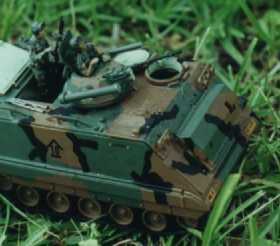
The AIFV approach of cutting down the rear troop area to fit firing ports and have the dismount squad leader alongside the TC in his own cupola/hatch is used by Korea, Beligium, Italy is another option.
The Singapore Army "ULTRA" M113 has mounted on its roof a power-operated Rafael Armament Development Authority Overhead Weapon Station (OWS), armed with a 25mm M242 Bushmaster cannon and a 7.62mm coaxial machine gun, with the gunner aiming the weapons via a day/night sighting device located in the hull.
The Rafael OWS has been in volume production for some years for installation on armoured fighting vehicles of the IDF, as well as for many export customers such as Romania (armed with Oerlikon Contraves 25mm cannon) fitted on the MLI-84, and Singapore (armed with 25mm M242 cannon) mounted on an M113. As an option, an externally mounted anti-tank guided missile can be fitted.
The standard vehicle provides protection through a full 360 degrees against 7.62mm armour-piercing attack and through a 30 degree frontal arc against 12.7mm attack. With the optional Rafael passive add-on armour kit it has protection through a full 360 degree arc against 12.7mm attack. Rafael has also developed a new hybrid add-on insensitive explosive reactive armour pack which provides protection against weapons such as the RPG-7 as well as 14.5mm armour-piercing attack.
The Raphael Remote Control Weapon Station had been selected by the Canadian Armed Forces for installation on its upgraded Bison and enhanced M113 series APC "T-LAVs". A lower profile version was evaluated for the U.S. Army Brigade Combat Team .50 caliber Heavy Machine Gun application but the Army for absurd reasons chose a remote weapon system from another company that is so slow you could hand traverse a machine gun on a ball-bearing ring mount faster.
Another option: the AV-30 High Performance One-Man Turret
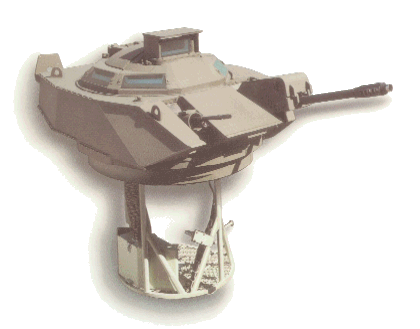
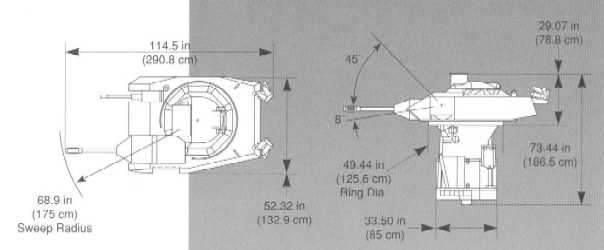
Legendary tanker and small arms expert Stan Crist recently proposed M113 Gavins with AV-30 autocannon turrets in issue #26 of Special Weapons for Military and Police magazine. He supplied 1st TSG (A) with the following information and photos. Thanks, Stan!
The AV-30 turret is a growth version of the Up-Gunned Weapon Station (UGWS II) turret which has been in production by AV Technology for the U.S. marine corps' AAV-7s since 1988.
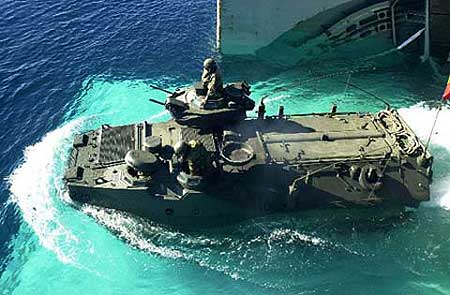
If the U.S. Army stopped wasting $BILLIONS of taxpayer dollars on rubber-tired Stryker deathtraps it could discover like the USMC an affordable 1-man turret upgrade that could be fitted to create advanced M113A3/4 Gavin light and M2A4 Bradley medium infantry fighting vehicles superior to anything else in the world. When the U.S. Army decides to get serious about combat capabilities instead of Tofflerian/RMA computer technohubris we might see common sense upgrades like AV-30 turrets on M113 Gavins.
AV Technology, LLC, has developed the combination AV-30mm/12.7mm (.50 caliber heavy or 7.62mm machine gun) turret for the world-wide market. Featuring a 30mm cannon, a day/night sight and high performance digitally controlled stabilized drives, this turret offers a substantial upgrade in firepower over other turrets in its class. The 30mm ammunition family used on AH-64 Apaches and AV-8B Harrier IIs is extremely powerful and long-ranged.
The high-performance turret drives, produced by Lockheed Martin, features high accuracy, rapid acceleration and smooth tracking. Combined with the turret's automated fire control suite, these drives assure a high probabilty of first round hit, even while shooting-on-the-move.
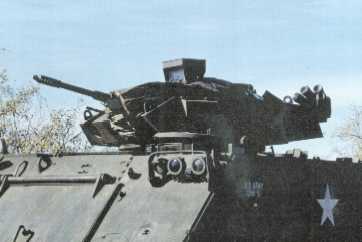
The former McDonnell Douglas (now Alliant TechnoSystems--ATK) 30mm M230 autocannon in the primary armament. In production for the U.S. Army AH-64 Apache attack helicopter program, this gun provides a substantial increase in firepower and survivability to a broad range of lightly armored vehicles, especially the M113 Gavin and M2 Bradley which could optimize the AV-30 1-man turret because it would not smother the infantry squad riding in the back as takes place with the overly large 2-man turret on the M2 Bradley.
The Kollsman Day/Night Range Sight (DNRS) allows the acquistion of targets at extreme ranges. At night and in inclement weather, the gunner has a view of the battlefield which is superior to that of any comparaby priced FLIR or night vision technology.
GENERAL
* Standard Interface
* Weight combat ready: <2,350 pounds
* Power: nominal 24vDC; max re. 150 amps, 30 amps under normal stabilization, 1 dome and 1 utility light
* Armor protection: standard NATO 7.62mm ball 0 degrees at 0 meters
* Optional 14.5mm HMG protection
OPTIONAL NBC
* Crew-served blower and filters
* Crew systems: 3-speed blower with C2 filter supplies M28 face mask
ENVIRONMENTAL
* Toxic gas compliant
* Heat: 130 degrees F; Cold: -30 degrees F
* Humid and wet conditions
* EMI shielded
* RAD hardened stabilization
ADDED FEATURES
* GPS available
* Standard AN/VRC-12 family of radios and intercom ready radios
* Smoke dischargers: M257, 8 ready rounds
* All ammo boxes fitted with low ammo sensors
FIRE CONTROL (Kollsman DNRS System)
STABILIZATION SYSTEM
* <.5 mrad accuracy
* Two-speed system
* Digital computer control (standard Bradley system baseline)
* Three-Gyro control (hull reference not needed)
* ABIT (Advanced Built-In Test) standard
* Traverse speed: >60 degrees/second, <.05 mils/second
* Elevation +45 degrees, -8 degrees depression
* Traverse: continuous
FIREPOWER
* Main armament: 30mm M230 Chain Gun, 175 ready rounds
* Co-ax 7.62mm medium Chain Gun, 440 ready rounds or:
* Co-ax .50 cal (12.7mm), 200 ready rounds
* 30mm penetration: 50mm (2 inches) RHA @ 2000 meters M789 HEDP
Andy MacDougall's 30mm Autocannon Turret Proposal

NOTE: the picture dosn't show the second Javelin tube, which reduces the height and allows "a second shot". The modified CLU/Combined Sighting Unit then looks down the center of this triangle. Also mounting it above allows greater depression of the gun tube, and full 360* traverse and so troops in the top hatch can reload-on-the-move.
The gas-operated ASP-30 autocannon fires with low-recoil and shock forces such that it can be fired by the crewman unbuttoned---in other words his head can be outside the turret. This is true for the M230 electrically-operated 30mm autocannon used on the AV30 but the ASP-30mm is simpler and lighter so it can be removed and fired on a tripod on the ground. This is why the ASP-30 is offered as a replacement for the .50 cal HMG on M113A3 TC cupolas. The heavier (unable to fly by Army helicopters) BFV's 25mm M252 high-velocity gun is lethal to friendlies who have their heads out from concussion and noise effects.
The ASP-30 will kill enemy personnel carriers and infantry fighting vehicles as handily as the BFV's 25mm chain gun can, ask AH-64A Apaches pilots from Desert Storm who have the M230 on their aircraft.
http://www.atk.com/conmun/descriptions/medium-cal-ammo/lw30mm.htm
LW ASP-30 30mm Ammunition
Outstanding armor penetration and fragmentation characteristics provide multi-role, multi-target capability
Alliant Techsystems provides the United States and its allies with a multi-service family of lightweight 30mm (LW30mm) ammunition. Developed and fielded for the electrically-fired M230 "chain gun" on the AH-64 Apache helicopter, the ammunition is also fully interoperable with the Boeing Phantom Works "ASP-30" gas-operated gun system. Combat proven in operations Just Cause and Desert Storm, the LW30mm has demonstrated excellent armor penetration at ranges from 150 to 4,000 meters, effectively defeating the BMP fighting vehicle threat. Because of its light weight, small volume, and moderate recoil, LW30mm ammunition is ideal for helicopters, light ground vehsicles (such a the HMMWV), and shipboard applications. Proven effective against light armor and materiel targets, it provides suppressive firepower at ranges equal to those of the Hellfire or TOW missile, making it the ammunition of choice for applications requiring both armor defeat and wide-area lethality. The LW30mm ammunition features a spin-compensated, shaped-charge liner, providing superior armor defeat plus additional growth potential. It also incorporates a high-performance, mechanical point-detonating fuze with impressive long-range performance and graze sensitivity. Outstanding armor penetration, combined with blast concussion and fragmentation characteristics, give the LW30mm ammunition superior multi-role, multi-target capabilities.
A family of LW30mm ammunition consists of two rounds: M789 High Explosive Dual Purpose (HEDP) and M788 Target Practice (TP). A High-Exploive Incendiary Tracer is also being fielded. The M789 HEDP is the main combat round. It has a heat-treated steel body loaded with 27 grams of PBXN-5 explosive and a fluted copper shaped-charge liner. This advanced design ensures superior performance against threat armored vehicles.
Alliant Techsystems designed and developed the M759 fuze used on the HEDP round. Point-detonating, the M759 offers advanced performance features such as dual safety, longer arming delay, shallow graze function, and greater long-range impact functioning.
The M788 TP is a low-cost, ballistically matched, inert training round. It is produced from the same quality materials and with the same exacting processes as the combat round.
NSN: 1305-01-268-7274/B129 1305-01-268-7274/B118
The Javelin is a "fire & forget" missile that has no backblast--its "soft launch". If anyone's head is out of the vehicle when the Javelin fires, no problem. The Javelin missile at 35 pounds is difficult to man-pack so various human powered mobility devices are being used like SKEDCO and ATACS. However, a light tracked armored vehicle like the M113A3 Gavin with Javelin mounting would protect gunners from enemy artillery fires and provide more missiles to fire at higher ground speeds. A HMMWV/Javelin mount has already been successfully fired and can be adapted to the M113A3 Gavin. The Javelin kills tanks from the top-down, enemy helicopters or bunkers as the missile guides itself on the heat signature--the vehicle doesn't have to be stopped and the Gunner DOES NOT HAVE TO track the missile all the way to the target, he fires and the missile guides itself all the way to the target. The vehicle can be driven to "shoot" and then "scoot" to protective cover or a different firing position. Javelin mounts for the HMMWV 4x4 truck fitted to designated M113A3s supplied to the "Delta" Companies of U.S. Army Airborne, Air Assault and Light Infantry Divisions would give them mounted, armored anti-tank and precision urban combat target destruction capabilities.
Both systems would be aimed by a Forward Looking InfaRed (FLIR) sight.
You can see the pay-off----M113A3, Wiesel 2 and BFV infantry can have the top troop hatch OPENED so they can fire their weapons and give greater vigilance and situational awareness than if they are closed up in the back. If artillery fire is received, everyone buttons up and the dismount infantry "see" with a large TV screen. Both the 30mm and the Javelins can be fired without risk of infantry in the back being harmed as the "blind" BFV set-up has us now. We make the M113A3 (Infantry Battalions) and the Wiesel 2 or BV-206S M973A2 SUSV (RSTA) as the baseline vehicles for the Army's new IBCTs and equip them with 30mm/Javelin turrets.
POSITIVE RIPPLE EFFECTS OF A SMALLER BFV TURRET...

Smaller turrets will eliminate scenes like above where BFVs become defacto medium-weight machine gun "female" tanks
THE SOUTH KOREANS HAVE IT RIGHT: AIFV WITH AV30 30mm TURRET!

The solution is to put a new, smaller one-man turret on the BFV that does not hinder the involvement of the infantry in the back so they are not made into "second class citizens" or abandoned as the primary maneuver element in the BFV Mechanized-Infantry company. Armies that have already figured this out include; South Korea (see AIFV photo above), Netherlands, Belgium, Italy, Turkey, Pakistan....BFV units that are infantry-centric will not have to be retrained for months for JRTCs/Kosovos/Guerrillas-in-Iraqs yet can "kick-ass" if they fight Desert Storms mech wars. They would not be spending endless hours in the motor pool or flailing about on Table VIII gunnery. We propose a 1-man turret with ASP-30 or M230 30mm autocannon with twin Javelin ATGMs as the answer. The ASP-30 fires with low-recoil and shock forces such that it can be fired by the crewman unbuttoned---in other words his head can be outside the turret. This is why the ASP-30 is offered as a replacement for the .50 cal HMG on M113A3 TC cupolas. The heavier (unable to fly by Army helicopters) BFV's 25mm M252 high-velocity gun is lethal to friendlies who have their heads out from concussion and noise effects.
The ASP-30 will kill enemy personnel carriers and infantry fighting vehicles as handily as the BFV's 25mm chain gun can, ask AH-64A Apaches pilots from Desert Storm who have the M230 on their aircraft.
The Javelin is a fire/forget missile that has no backblast--its "soft launch". If anyone's head is out when the Javelin fires, no problem. The Javelin can kill tanks from the top-down, enemy helicopters or bunkers as the missile guides itself on the heat signature--the vehicle doesn't have to be stopped and the Gunner tracks the missile all the way to the target. The vehicle can "shoot" and then "scoot" to protective cover or a different firing position.
Both systems would be aimed by a Forward Looking InfaRed (FLIR) sight. The Commander would have a helmet-mounted sight system to better perform vehicle command and gun tasks.
If you look at the picture, you see the pay-off----M113A3, Wiesel 2 and BFV infantry can have the top troop hatch OPENED so they can fire their weapons and give greater vigilance and situational awareness than if they are closed up in the back. If artillery fire is received, everyone buttons up and the dismount infantry "see" with a large TV screen.

Both the 30mm and the Javelins can be fired without risk of infantry in the back being harmed as the "blind" BFV set-up has us now. We make the BFV, M113A3 and the Wiesel 2 or Bv206S as the baseline vehicles for the Army's new BCTs and equip them with 30mm/Javelin turrets.
We replace all BFV turrets with 30mm/Javelin turrets to lighten the BFV from 33 tons to under 30-tons, lower its silhouette, eliminate the need to man a "Gunner" position, increase the space inside to carry a full 9-man squad instead of a crammed in 7. All while INCREASING firepower, survivability and returning the training focus back to being infantry-centric where it should have been all along. With the rear cargo hatch of the BFV open to give the dismount leaders real SITUATIONAL AWARENESS not the "do-as-you-are-told-you-are-inferior-beings-we-will-feed-you-tv-imagery-from-the-gunner's-camera-view" garbage.
We need MECH infantry to not be "slugs"; for without them and we try to fight "light" pure we will get October 3, 1993 "Somalias" or 1943 "Cisternas". If they hide out in their vehicles we will get 'Grozny". We can stop the Mech infantry from being looked down upon by rewarding ALL U.S. Army Combat Arms Soldiers their own Brown Beret upon completion of their AITs.
www.reocities.com/Pentagon/Quarters/2116/bberet.htm"
BETTER ARMOR PROTECTION
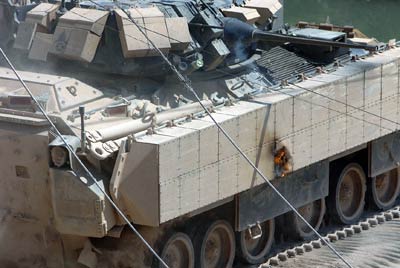
Despite being struck by an enemy rocket-propelled grenade, an Army Bradley
Fighting Vehicle brings supplies to "F" Troop, 4th U.S. Cavalry, during a gun
battle with insurgents south of Baqubah, Iraq, that lasted 12 hours. Original photo location: www.armytimes.com/content/editorial/editart/061804front22.jpg
Notice that the ERA counter-explosion was not some huge conflagration. This
fear that infantry nearby would get hurt from the ERA counter-explosion so we
can't use ERA looks like a self-defeating myth.
The Army through the capable Israeli company RAFAEL is trying to apply ERA
"icing" to the bogus Stryker "cake" to excuse away some of its weaknesses. This
will not enable Stryker to not get stuck in mud or be easily mobility killed
through its air-filled rubber tires that easily burn. An enemy attacking
Strykers/w-ERA will simply employ counter-mobility devices to immobilize them if they try to go off-road, use same devices on roads to stop the lead vehicles to create catastrophic ambushes. Instead of attacking with RPGs, they'll save
their rockets and throw bottles of gasoline/oil with lit rags at the Stryker's
many rubber tires.
Iraqis torching wheeled truck convoy with bottles of fuel
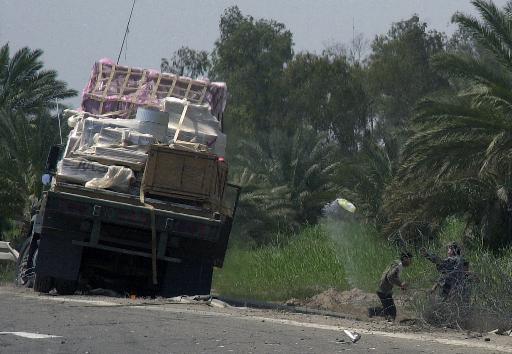
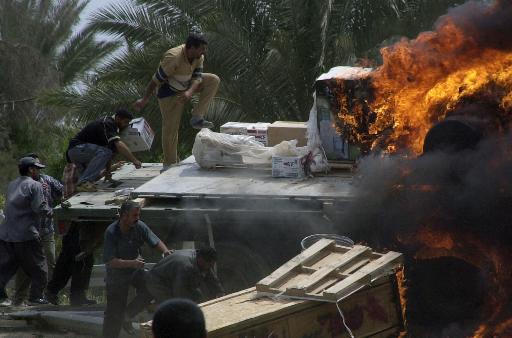
The ugly question is why is ERA not on M113 Gavins when years ago the RAND
study concluded 60% coverage was possible compared to just the 35% ERA coverage
now on the BFVs that are lucky to have ERA.

BFVs in Iraq have suffered preventable casualties had adequate applique' armor and gunshields been fitted. One thing that can be done quickly is fit external troop storage racks like the BFV above has done to add a layer of protection to pre-detonate RPGs without making BFVs any heavier.
The 1999 RAND study on reactive armor shows that M113 Gavins can be more RPG/ATGM protected than BFVs because their shape allows 60% coverage compared to only 30% coverage for the latter.
www.rand.org/publications/WP/WP119/
Yet, the Army's senior leaders refuse to up-armor our winning tracked AFVs in favor of squandering $BILLIONS on inferior, rubber-tired HMMWV and Stryker trucks or any sexy-to-them electronic mental Tofflerian/RMA gadgets that come along.
WHERE ARE THE BRADLEY SHIELDS?
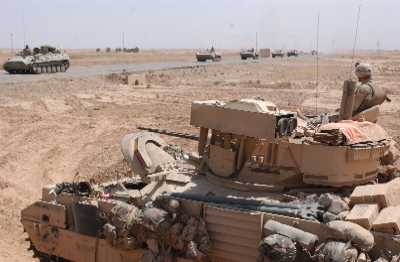
On June 24, 2004, in Iraq, Captain Chris Cash was riding in the turret top of a Bradley Fighting Vehicle which the Army has neglected to fit shields for like its M113 Gavins can have fitted. An enemy bullet hit him in the head and he died, leaving behind a wife and 2 sons.
We have known continually from Fort Polk, JRTC and Fort Irwin, NTC force-on-force MILES laser tag war games that crewmen in Bradleys, Abrams and Gavins can be killed from sniper's bullets if not fitted with shields. The same applies to HMMWV trucks which after Somalia received gun shield kits but the enemy just has to shoot through the weak body of the vehicle and through its windows and doors to kill and maim. The Army's tracked armored fighting vehicles (AFVs) with solid bodies could be made fully RPG and roadside bomb resistant with multiple layers of armor and be operated safely from open hatches to see outward and respond to the enemy first---if the Army cared to upgrade them.
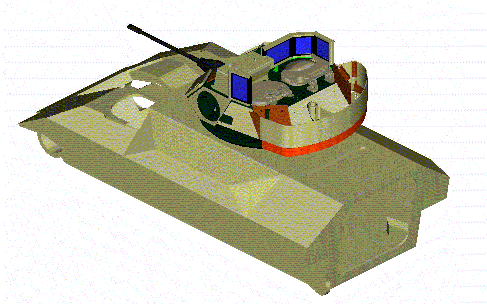
The good news is that manufacturers are ready to make clear ballistic shields for BFVs (see computer drawing above). Further investigation of this preventable tragedy reveals that clear ballistic shields for Bradleys are available if the Army asks for them, but apparently the Commanding General of Fort Benning--a man who goes by the strange name of Freakley doesn't want to spend the estimated $3,000 per Bradley to save the Soldiers who walk down the same corridors of Building 4 as he does daily; which included at one time Chris Cash. The irony here that a good man and infantry officer has died because one bureaucrat in the Army doesn't want to spend the "cash" is not a "freak" occurrence. It would be even funny if it were not that we have already lost dozens of real Soldiers to real bullets while operating unshielded M2 Bradleys and M1 Abrams, medium and heavy tanks. However, some people in our Army do not care about its tracked vehicles or the men that use them and want to instead waste billions instead on rubber-tired HMMWV and Strykers trucks that can never be adequately protected or maneuverable enough on the non-linear battlefield where close-range combats are the rule not the exception. They'd rather spend $3.3 million for each Strykers truck that is hidden in a quiet place in Iraq than spend $3 thousand dollars per Bradley, Abrams or Gavin to save heroes like Chris Cash who are actually engaged in combat.
USING YOUR TAX DOLLARS WISELY?
We need VICTORY as we got in Panama by an air-delivered MECH-LIGHT-ARMOR team, which is now weakoned by the abandonment of the M551 Sheridan and M8 Buford Armored Gun Systems. We still have M113A3s, we ought to use them. Instead of wasting money on expensive $28-45 million dollar fighter jets useless in a close city fight, (marines crash and burn a dozen a year), we should use the money to buy a platoon of light, air droppable Buford tanks at $5 million each that would last us for decades like the M551 Sheridans did. The M8 uses the same engine as Army trucks and parts from other AFVs like the M113 Gavin already in use so its adoption/field use would be inexpensive. We can easily upgrade BFVs with smaller 1-man turrets and shields.
www.ausa.org/landwar/item/views/defense979.html
www.reocities.com/Pentagon/Quarters/2116/armored.htm
AIRBORNE!!!
REFERENCES (if you print this article these will be visible)
_____________________________________________
Combat Lessons Learned
www.strategypage.com/dls/articles/20030912.asp
Unclassified After Action Report From Iraq
September 12, 2003
24 APRIL 2003
SUBJECT: Operation Iraqi Freedom After Action Review Comments
1. The purpose of this document is to provide after action review comments after combat operations conducted by TM C/3-15 Infantry, Task Force 1-64 Armor "Desert Rogues" during "Operation Iraqi Freedom.
2. All comments will be broken down into the following format: issue, discussion, and recommendation.
3. Doctrine/TTP's (Tactics, Techniques and Procedures).
Issue: Current Urban Operations Doctrine does not support operations conducted by this unit.
Discussion: The current doctrinal manuals on Urban Operations do not address how best to utilize armored forces in an urban environment. The enemy faced by this unit hid his tanks and vehicles under camouflaged covers, beneath bridge overpasses, inside of buildings on narrow streets, and under low trees. These enemy systems were not seen until they were only meters away. No degree of IPB (Intelligence Preparation of the Batlefield) could compensate, alert, or prepare any US force for the massive numbers of RPGs (Rocket Propelled Grenades) stored in houses, shacks, lockers, and cars. The only way to counter RPGs fired from covered and concealed positions was to absorb the hit, identify the source of the fire, and respond with massive overwhelming firepower.
Tanks and Bradleys repeatedly sustained hits from RPG's and ground directed anti aircraft fire that dismounted infantrymen, HMMWVs and other light skinned vehicles could not sustain. Bradleys successfully protected the infantrymen inside while at the same time delivering a massive volume of fire against dismounted enemy, trucks, tanks, and armored vehicles. The firepower and shock generated by tanks and Bradleys could never have been matched by dismounted infantry. Without the use of these systems initially, the enemy would have caused many more casualties.
The current doctrine recommends clearing the built up area with dismounted troops prior to any armored vehicles entering. This Task Force proved that this is not a requirement and is not necessarily the best initial course of action. By moving armored vehicles along a pre determined route and destroying any enemy forces whether dug in, in buildings, or on roof tops with massive overwhelming fires from M1A1 tanks and M2A2 fighting vehicles, an entire line of communication can be opened up allowing access not only into the built up area but through it also. Once the line of communication is open, clearing operations with dismounted forces are much easier. A key to this is the overwhelming psychological effect the firepower of these weapon systems have on the enemy once the initial raid is conducted, almost all remaining enemy forces will withdraw from the initial shock. This initial shock of overwhelming firepower facilitates the attacks of dismounted infantrymen into the built up area.
Recommendation: The BCT submit to the United States Army Infantry School and the United States Armor School an update to the current urban operations doctrine. Additionally, send only vehicles that can sustain RPG hits into urban combat zones.
Issue: Problems arising from the simultaneous conduct of SASO (Stability and Support Operations) and combat operations in Iraq.
Discussion: After less than 48 hours after the first battlefield engagement, members of this company team were tasked to conduct checkpoint operations southwest of An Najaf. With no training, soldiers were expected to search vehicles, interact with civilians with no CA (Civil Affairs) or PSYOPS (Psychological Warfare) support, detain EPW's (Enemy Prisoners of War), and confiscate weapons. Less than 48 hours after this, the unit was again heavily engaged in combat operations. The radical and swift change from combat operations to SASO and back to combat operations over and over again causes many points of friction for the soldiers and their leaders.
With the exception of a class given to the platoon leaders, there were not formal classes or training conducted by CA prior to the operation. No training on checkpoint operations or dealing with civilians was received.
Material resources continued to be an issue. The team brought extra CL IV on all vehicles in anticipation of having to conduct blocking operations but the capability to haul the quantities required by SASO was not there. Having emplaced checkpoints on four different occasions, by the time the unit reached Baghdad, there was no remaining CL IV (construction and barrier materials). The unit was in desperate need of materials for force protection. It took weeks for materials to arrive; in the meantime the unit utilized destroyed cars, flower posts, bicycle racks, and whatever else was available for force protection.
Interpreters were not available to the company team at any point during the operation. These interpreters are critical to the team's ability to interact with civilians, discern their problems, and broadcast friendly unit intentions. Often times the unit had crowds and upset civilians to deal with and absolutely no way to verbally communicate with them.
Lack of information from higher headquarters greatly complicated the task of converting from high intensity conflict to SASO. Weeks after occupying Baghdad in force, the unit is still unable to direct the civilian populace to humanitarian agencies other than the Red Crescent. We have no way to direct people to places to receive food and water, to search for loved ones, to located deceased personnel. The unit did not have the ability to answer any questions simply because of the unsynchronized and unplanned operations of the Civil Affairs community and other non-governmental organizations.
The problem with the switching from combat to SASO is the impact on the soldiers and leaders of the unit. Transitioning from combat to SASO requires a substantial and fundamental shift in attitude. The Soldiers have been asked to go from killing the enemy to protecting and interacting, and back to killing again. The constant shift in mental posture greatly complicates things for the average Soldier. The Soldiers are blurred and confused about the rules of engagement, which continues to raise questions, and issues about force protection while at checkpoints and conducting patrols. How does the soldier know exactly what the rule of engagement is? Soldiers who have just conducted combat against dark skinned personnel wearing civilian clothes have difficulty trusting dark skinned personnel wearing civilian clothes.
Recommendation:
A. Integrate SASO training into the unit METL (MISSION-ESSENTIAL TASK LIST). This was has provided ample instances where units are conducting both combat and stability operations at the same time. Thus, we should no longer expect to be able to compartmentalize ourselves as either "war fighter: or "peacekeeper". With the ever-present threat of terrorist attack, it is critical that soldiers know the correct tactics, techniques, and procedures for providing security while also enforcing peace.
B. Heavy duty CL IV materials are required for blocking positions and should be maintained at the task force or BCT level. Lift and freight assets need to be responsive and capable of delivering reinforcing materials in short order.
C. Civil Affairs, pysops, and interpreters must be integrated at the company team level. Every checkpoint must have an interpreter and these interpreters must be with the company team throughout the operation as it is impossible to predict when you may be required to fight or keep the peace.
D. Improved information flow and the quicker establishment of Civil Military Operations Centers. Units occupying positions in built up areas make frequent contact with civilians. Information and a centralized theme must be passed to the company team level as quickly as possible to ensure the proper message is being sent to the populace, and in turn, input from the populace is reaching the highest levels. The company team level is the level where the interaction with the populace occurs.
E. We must train our leaders and Soldiers in the conduct of SASO operations. Leaders must be sensitive to the flux between war fighting and peacekeeping and the demands of each not only on the unit but the individual. We owe it to our soldiers to train them on the differences. It is the responsibility of leaders to ensure PVT Plunger and PVT Snuffy know what the proper posture or attitude is and to enforce it.
Issue: The employment of Hunter Killer teams.
Discussion: This unit, while conducting combat operations, had great success through the utilization of hunter killer teams. The combination of scouts with LRASS (Long-Range Advanced Scout Surveillance System) and tanks and fighting vehicles proved invaluable at the detection and destruction of enemy vehicles and dismounted infiltration attempts.
By locating a scout section with LRASS, which could observe out to 10,000m, at a location that had maximum observation, the scouts, could provide real time intelligence and 10 digit grid locations to the company team enabling the company team to move to and engage with direct fires and/or utilize mortar fires to destroy enemy forces. This proved to be a great TTP (Tactics, Techniques and Procedures) while at OBJ RAMS, An Najaf, and while blocking on HWY 1.
Recommendation: Doctrine be published based upon the success of the task force operations utilizing hunters and killers, specifically, integrating scouts, infantry, and armor forces into an effective organization which can identify, assess, and destroy the enemy.
4. Training
Issue: Urban Operations Training for armor forces
Discussion: The armor platoon attached to this CO/TM was fortunate enough to receive UO (Urban Operations) training prior to operations in Iraq. They learned valuable lessons such as firing from the GAS sight at extremely close ranges, entering a battle sight range of 300m while in urban environments for the main gun, and decentralizing the location of CL I (food), water, and CL III(P) (fuel) on the tank in order to protect from losing all supplies due to a single hit or building strike. They learned to keep their tanks out of intersections and to scan the upper stories of buildings and rooftops for enemy forces. They practiced transporting infantry and coordinating direct fires with dismounted forces. These and other TTPs gave the platoon the confidence and experience required when attacks to Baghdad and raids south on HWY 8 were conducted.
Recommendation: All armor platoons should be trained and integrated into urban operations training. Although the tactics trained may not have been executed, the lessons learned regarding load plans, fire control system adjustments, fire patterns, and scanning responsibilities were instrumental to the platoon's success. Every effort should be made to teach these lessons prior to combat.
Tank platoons should also train with a dismounted squad under the control of a tank platoon leader. At a battle position in Baghdad, 3/A/1-64 AR was attached a weapons squad from an infantry platoon. These Soldiers were critical to the platoon's defense. They were tied in between two tanks along a dismounted avenue of approach. It was composed of a heavy tree line and thick vegetation that closed to within 50 meters of the platoon's position. The squad repelled an RPG team's attempt to infiltrate the platoon BP and also cleared seven bunkers full of weapons and ammunition. These feats could not have been accomplished without the task organized infantry squad.
Issue: Machine gun engagement training for loaders.
Discussion: Thanks to numerous live fire opportunities, the armor platoon loaders were all experienced in firing the loader's M240 machine gun prior to operations in Iraq. When battle came, these soldiers comfortably understood the behavior of their weapons system and were able to place effective, deadly fire on the enemy. There was a dramatic improvement in their performance from the first time they fired their machine guns in training to the use of the weapons in combat.
Recommendation: Incorporate a loader's engagement into Tank Table VIII scenarios. This will compel units to train loaders on their weapon system and give loaders invaluable experience and opportunities to refine their techniques. This unit was fortunate enough to have the time and ammunition to learn these skills on their own; others may not have that luxury.
5. Equipment.
Issue: The lack of adequate armor on the flanks of Bradley and Tank turrets and hulls.
Discussion: Enemy fire from recoilless rifles and RPGs was able to penetrate fuel cells, turrets, and ammunition compartments at ranges of less then 200m. Penetrations in tanks occurred in armor behind the number six skirt and in the turret armor at the rear corners of the turret.
The Task Force was not issued reactive armor for the Bradley Fighting Vehicle even though it is available in the Army system. This armor would have prevented the 4 direct penetrating hits from RPG rounds received by fighting vehicles in the task force.
As a result of not being issued reactive armor, both Bradley and tank crews had to "create" their own armor through the use of rucksacks, water boxes, MRE's, etc. All of which helped but were still penetrated by the RPG and recoilless rifle rounds.
Recommendation: Issue reactive armor to all available vehicles to prevent penetration by AT systems. Ballistic skirts should be fitted along the entire flank of vehicles going into urban combat. Reactive armor on the turret flanks and the turret top would protect the crew from anti tank weapons fired from rooftops as well as ground level.
The armor packages need to be modular and configured so that the crew or organizational mechanics can apply or remove the armor.
This armor is currently available for the M2A2 but needs to be made available for the M1A1 and the M113 series vehicle for the conduct of combat in urban operations.
Issue: Lack of a Bradley CDR (commander) weapon system.
Discussion: During the conduct of urban operations by this unit, due to limited visibility within the turret and the threat encountered not only from the front but from both flanks of the vehicles, Bradley commanders were required to expose themselves outside of the turret in order to acquire enemy forces, to control movement, and protect their own vehicles. As a result of this, most BC's adapted to this and began to keep M231 port firing weapons and "bags of hand grenades" on top of their turrets in order to defeat enemy forces in close proximity to their vehicle or enemy forces on the side opposite of gun tube orientation.
Recommendation: A M240 machine gun similar to that mounted on the M1A1 tank for loaders, be mounted on the M2 Bradley Commander's Turret. This would enable the BC to defend his vehicle from threats opposite of the gun tube and also in close proximity to the vehicle. BC's would no longer be required to keep their personal weapons or hand grenades on top of the turret in order to repel enemy attacks.
Issue: Effective communication between tanks and dismounted Infantry.
Discussion: On several occasions, infantry squads were attached to the armor platoon in the CO/TM to provide additional security at checkpoints/blocking positions and to defend dismounted avenues of approach at battle positions. The tanks were forced to utilize Motorola "talkabout" radios to communicate with the squad. This was problematic for several reasons: 1. Lack of net security, 2. "Talkabout" radios are not integrated into the tank internal communication system, 3. Lack, or prohibition of "talkabout" radios in theater. This is the same problem encountered by infantry platoons due to the lack of dismountable frequency hop capable radios at the platoon level.
Recommendation: Issue PRC148, frequency hop capable radios, to all infantry squads or give each tank platoon an extra dismountable SINCGARS radio. TA1 phones mounted externally to the tank proved to be inadequate. They were unreliable and lacked the flexibility to successfully move with the infantry as they left their holes and cleared bunkers.
Issue: Loaders exposed to enemy machine gun fire at close range in urban operations combat.
Discussion: Loaders played a critical role in identifying, suppressing, and destroying enemy infantry, vehicles, and RPG teams on the flanks of their vehicles down alleys and behind buildings as we advanced in column along roads. The observation and suppression abilities of loaders are critical to the success of the tank and the unit and compel them to stay outside the loader's hatch. However, the only protection for loaders against enemy small arms fire came from the spall vests and effective suppression of the enemy. Had enemy fire been more accurate or intense, many loaders would have been killed or wounded.
Recommendation: Develop and employ an armor plate that attaches to the loader's M240 machine gun mount and covers the vital areas of the loader's body. It should be easy to add or remove quickly (within seconds) in order to facilitate the expedient closure of the loader's hatch. It must be capable of stopping 7.62mm fire.
Issue: Need for more effective anti personnel capability for the M1A1.
Discussion: The majority of enemy forces faced were dismounted infantrymen. They could be effectively engaged and destroyed by 7.62 and .50 CAL fire. This, however, took time, and forced loaders and tank commanders to repeatedly expose themselves to reload under close combat. These small arms also hindered the fast clearing of fields of fire in thick vegetation.
Recommendation: Develop and field 120mm anti personnel munitions for the M1A1. The additional shock and firepower of anti personnel main gun rounds such as white phosphorous and "beehive" would have facilitated the quicker destruction of the enemy and the collapse of his will to fight. Due to burning or shotgun like effects, these rounds also bring about the quick exposure of camouflaged enemy positions. This, in turn, translates, into safer conditions and fewer US casualties.
Issue: The lack of proper night vision equipment and target acquisition systems.
Discussion: Elements of this unit consistently hesitated to engage and destroy enemy forces due to caution and the inability to clearly identify the enemy in daylight, thermal, and passive night vision sights. The Army's current policy of outfitting light units with the newest night vision technology, specifically passive night vision, is seriously flawed as demonstrated during this conflict. The PVS 7As currently utilized by most members of the company team proved all but worthless. The light units simply followed the heavy units which reinforces the need for the mechanized and heavy units to have the newest in night fighting equipment as heavy units are much more versatile than light units ever dreamed of being. Several vehicles crashed into berms and wadis due to the lack of proper night vision equipment. GPS and TIS sights could not provide positive identification of small arms, RPG's, or mortars beyond 800m, thus making it impossible to determine enemy activity or presence on vehicles without closing range or aid from scout vehicles.
Recommendation: At a minimum, upgrade the thermal sights on the M1A1 tank and M2A2 Bradley. Provide the most up to date passive night vision to heavy units, even if it means taking it from the "premier" light units who in fact followed this unit throughout Iraq. It would be ideal to see 3rd generation FLIR, CITVs, and fourth generation passive night vision.
6. Manning.
Issue: Three 9-man squads vs. two 9-man squads and a 9-man weapons squad.
Discussion: While conducting multiple dismounted operations, the ability to commit two maneuver squads and still retain the flexibility to maintain an adequate suppressive fire platform from the ground was very critical to the success of this unit in combat operations. Having the weapons squad in its entirety, to deploy and maintain an overwhelming amount of firepower, under the control of one competent squad leader, enabled the two maneuver squads to execute their assigned tasks with all nine of their soldiers. This allowed for the training conducted to be executed in the same manner. Through repetition, the squads were very proficient in the execution of room/building clearing. This allowed the squad leader and the platoon leader to concentrate on the clearing of the building.
Recommendation: The two 9 man rifle squads and one-man weapon squad should replace the current three 9-man squad concept. The current doctrine has one soldier qualified on three weapon systems, depending on the environment of the operation. This concept does not provide for the loss of one of those personnel. The composition of the weapon squad should be as follows: 1 SSG squad leader, 3 M240B machine gunners, 3 M240B assistant gunners, and 2 Javelin AT gunners.
7. Logistics.
Issue: CL IX (spare parts) parts flow throughout the operation was non-existent.
Discussion: Throughout the conduct of combat operations, the only CL IX parts available were those brought forward by the task force or those, which were cannibalized off of destroyed or damaged vehicles. This made maintenance operations difficult if not impossible for long periods of time.
Recommendation: A CL IX package specific to the unit be loaded onto vehicles which have the capability to move forward with the speed of the combat units and the ability to mount weapon systems in order to expedite the movement of parts forward to the war fighter and the UMCP. Without this capability, the unit loses combat power critical to the conduct of the fight or stability operations.
8. Maneuver.
They learned valuable lessons such as firing from the GAS sight at extremely close ranges, entering a battle sight range of 300m while in urban environments for the main gun, and decentralizing the location of CL I, water, and CL III(P) on the tank in order to protect from losing all supplies due to a single hit or building strike. They learned to keep their tanks out of intersections and to scan the upper stories of buildings and rooftops for enemy forces. They practiced transporting infantry and coordinating direct fires with dismounted forces. These and other TTPs gave the platoon the confidence and experience required when attacks to Baghdad and raids south on HWY 8 were conducted.
Recommendation: All armor platoons should be trained and integrated into urban operations training. Although the tactics trained may not have been executed, the lessons learned regarding load plans, fire control system adjustments, fire patterns, and scanning responsibilities were instrumental to the platoon's success. Every effort should be made to teach these lessons prior to combat.
Tank platoons should also train with a dismounted squad under the control of a tank platoon leader. At a battle position in Baghdad, 3/A/1-64 AR was attached a weapons squad from an infantry platoon. These soldiers were critical to the platoon's defense. They were tied in between two tanks along a dismounted avenue of approach. It was composed of a heavy tree line and thick vegetation that closed to within 50 meters of the platoon's position. The squad repelled and RPG team's attempt to infiltrate the platoon BP and also cleared seven bunkers full of weapons and ammunition. These feats could not have been accomplished without the task organized infantry squad.
Issue: Machine gun engagement training for loaders.
Discussion: Thanks to numerous live fire opportunities, the armor platoon loaders were all experienced in firing the loader's M240 machine gun prior to operations in Iraq. When battle came, these Soldiers comfortably understood the behavior of their weapons system and were able to place effective, deadly fire on the enemy. There was a dramatic improvement in their performance from the first time they fired their machine guns in training to the use of the weapons in combat.
Recommendation: Incorporate a loader's engagement into Tank Table VIII scenarios. This will compel units to train loaders on their weapon system and give loaders invaluable experience and opportunities to refine their techniques. This unit was fortunate enough to have the time and ammunition to learn these skills on their own; others may not have that luxury.
Issue: Attack aviation support was non-existent from LD throughout the entire combat operation.
Discussion: Throughout "OIF" from the crossing of the line of departure to the cessation of hostilities in Baghdad, the task force did not have any attack aviation support. As the brigade and division main effort, attack aviation should have been available at all times during combat operations or when enemy contact was likely. As it was, the aviators were not willing to fly to support the troops on the ground.
Recommendation: The method in which commander's plan to employ attack aviation as a combat multiplier needs to be reviewed. Currently, commanders and staffs rely too much on attack aviation being a combat multiplier when conduct combat ratios, when as in this fight, it is discovered to be unreliable or non-existent. Commanders and staffs must plan primarily for each fight without the support of "attack" aviation as the aviators are unreliable at best.
Issue: Special operations forces brought absolutely nothing to the fight during the conduct of combat operations but wanted support during SASO operations.
Discussion: Throughout this operation, special operations forces brought no information, which was of any value to the unit. In fact, never at one time did this unit have any special operations forces forward in zone or along an axis of attack providing critical information or intelligence. In fact, the situation was just the opposite. The special operations forces, hid or moved behind the protection of armored forces throughout the operation. This became especially evident during the transition from hostilities to SASO as this unit was tasked at least daily to provide either a QRF or transport to special operations forces into areas of the city to meet contacts or conduct "snatches".
Recommendation: Conventional ground commanders, the backbone of the army, cannot expect to receive any timely information from special operations forces during combat operations such as those experienced by this unit during "OIF". Additionally, the United States Army should review its current doctrine or lack of doctrine reference the integration of SOF and armor and mechanized infantry forces.
Leadership
www.reocities.com/Pentagon/5265/M113A3.htm
FM 23-24 Dragon ATGM manual
http://155.217.58.58/cgi-bin/atdl.dll/fm/23-24/toc.htm
Somalia firefight
www3.phillynews.com/packages/somalia/dec11/default11.asp
Fix infantry AIT
www.reocities.com/Pentagon/Quarters/2116/fixait.htm
Aircraft wastage
www.reocities.com/Pentagon/Quarters/2116/armored.htm
U.S. Army Brown Berets
www.reocities.com/Pentagon/Quarters/2116/bberet.htm
Want Pvt Murphy in your pocket?
 Return to Army Equipment Shop
Return to Army Equipment Shop
FEEDBACK!!!
itsg@hotmail.com
A former U.S. Army Infantry officer writes:
"Mike, the problem is a combination of things. First ever since Vietnam
the military has not purchased sufficient ammunition for its needs.
This includes training ammo. For small arms, grenades, mortars etc it
means you use ammo that's one step away from having to be destroyed.
Any of you that have ever thrown grenades in training might have noticed
high dud rates. I have fired 81mm mortar rounds made in 1943, .50 Cal
loaded in the mid 50's and 7.62 loaded near the beginning of Vietnam.
When it comes to Missile training rounds they frequently cost as much or
more than the Combat rounds thus making them to expensive to train with.
Example in 1985 a flash bang grenade cost $10 and a combat HE grenade
cost $5. Additionally there are few ranges in the U.S. where even
practice rounds can be fired. Computer simulation was substituted but
that doesn't work in most situations.
The next problem is doctrinal. With the advent of the Bradley we
adopted the same fighting doctrine as the Soviets. Roll over the
objective as quickly as possible and have the infantry jump out and
shoot who ever is still left alive. When the Iraqis faded away and we
had to start patrolling the cities in Hummers our Soldiers were totally unprepared for that mission because they weren't trained for it. The TOW launchers were added as an after thought to the Bradleys. When they first came out I remember we were told that it had to take a hit from a
SAGGER type AT round or a 125mm main gun round and Keep fighting. While
the Headshed deluded themselves for the next year we all knew better.
Besides the Bradleys were never meant to operate independently. They
were to provide security for the M-1's who would take out the tank
threat. Regardless of the TOW type - TOW (no longer in the inventory),
I-TOW, TOW-2, TOW2-B - they should always be fired from the stationary
position as they have only 64 course corrections and you can go through
those if you sneeze. Your comment on the lazy types remaining on board
is true. I went on a rotation at NTC with a company from 3 ID a number
of years ago. I saw it there. As a side note it was exactly this same
mentality that helped the Soviets lose the war in Afghanistan. The
troops didn't want to walk or risk getting shot so instead of getting
out and engaging the enemy they stayed inside and fired from the
infantry firing ports."























 Return to Army Equipment Shop
Return to Army Equipment Shop